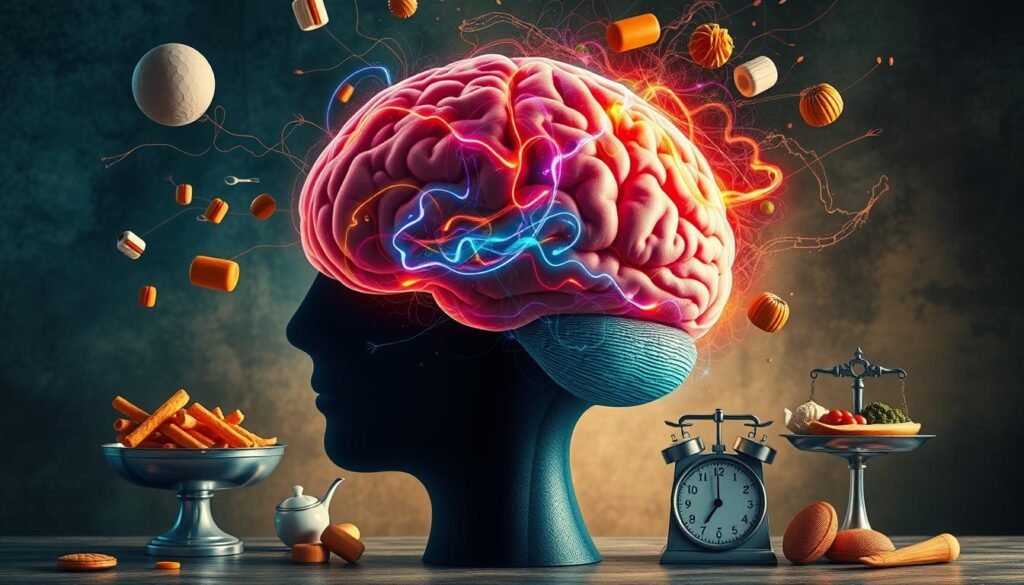Did you know about 30% of schizophrenia patients don’t respond well to first-line antipsychotics? This fact highlights the critical need for effective medications for those hard-to-treat cases. Clozaril, or clozapine, stands out among atypical antipsychotics. It is especially important for patients not helped by other treatments.
Clozaril was first made in the 1950s and became well-known in the 1970s. It works better than many traditional therapies. It’s special because it effectively helps those who have not benefited from other antipsychotics. However, it can be risky because it might cause agranulocytosis, a serious blood disorder.
This article will explore how Clozaril works, its benefits, and how it’s different from other antipsychotics. We’ll look closely at its importance in modern psychology.
Key Takeaways
- Clozaril is critical for treating treatment-resistant schizophrenia.
- About 30% of patients do not respond to standard antipsychotic treatments.
- Agranulocytosis poses a serious risk associated with Clozaril usage.
- Clozaril has shown superior efficacy over other atypical antipsychotics.
- This medication was developed in the 1950s and became significant in the 1970s.
Introduction to Clozaril
Clozaril, known as clozapine, is key for treating tough cases of schizophrenia. It tackles both the visible and hidden symptoms effectively. Unlike older antipsychotics, Clozaril reduces the chance of movement disorders. This makes it a top pick for complex treatment paths.
Before using Clozaril, patients need regular blood checks, especially early on. These tests spot serious side effects like agranulocytosis, which lowers white blood cells. Treatment starts at 100 mg twice daily, reaching a concentration of around 319 ng/mL in 2.5 hours. Regular monitoring is vital due to these risks, highlighting the need for careful medical guidance.
Clozaril isn’t right for everyone. Those allergic to clozapine or its parts should avoid it, as it could cause major health issues. Also, older people with dementia-related psychosis see higher risks with antipsychotics. They need a thorough check by doctors before starting on Clozaril.
For those hard-to-treat schizophrenia cases, Clozaril is a valuable option. Its unique action on dopamine and serotonin in the brain makes it highly effective. Clozaril’s significant role in mental health care stands out, especially for those who haven’t found relief elsewhere.
Understanding Antipsychotics
Antipsychotics are key psychiatric drugs used for schizophrenia and bipolar disorder. They split into typical (first-generation) and atypical (second-generation) groups. Typical antipsychotics mainly block dopamine receptors, controlling hallucinations. Atypical types, like clozapine, also affect serotonin receptors.
Atypical antipsychotics offer wider benefits and usually cause fewer side effects than typical ones. By 2016, the FDA had approved twelve atypical antipsychotics. These include risperidone, olanzapine, and quetiapine. Choosing the right treatment and understanding the drugs’ effects is critical for patient outcomes.
Patients with schizophrenia often need antipsychotics long-term. This helps control symptoms and avoid relapse. But, these drugs can increase diabetes risk, so monitoring is essential. Sometimes, combining them with other medications helps with anxiety and mood disorders.
The following table highlights key differences between first-generation and second-generation antipsychotics:
| Characteristic | First-Generation Antipsychotics | Second-Generation Antipsychotics |
|---|---|---|
| Target Symptoms | Primarily positive symptoms (e.g., hallucinations) | Positive and negative symptoms (e.g., emotional flatness) |
| Examples | Haloperidol, Chlorpromazine | Risperidone, Olanzapine, Clozapine |
| Common Side Effects | Extrapyramidal symptoms, sedation | Weight gain, metabolic syndrome |
| Indications | Tourette syndrome, acute agitation | Treatment-resistant schizophrenia, severe mood disorders |
Knowing the differences between antipsychotics helps doctors choose the right treatment. With ongoing advances, the role and improvement of antipsychotics is a key area in psychiatry.
Atypical Antipsychotics Explained
Atypical antipsychotics are a group of medications becoming more common for treating schizophrenia. They are more effective and have fewer side effects than first-generation options. This group involves drugs like clozapine, olanzapine, and risperidone. They work differently from older medications, focusing on dopamine and serotonin receptors.
These medications usually cause fewer movement disorders, a problem with older drugs. However, they can lead to weight gain and sedation. It’s important for doctors to understand these effects to best help each patient. Clozapine is notable for its ability to help those who haven’t responded to other treatments and lower the risk of suicide.
Research shows atypical antipsychotics can change the brain, especially the thalamus. MRI studies show they affect brain structures in different ways. Understanding how these drugs work is key for doctors choosing the right treatment. The effectiveness and safety of these medications, their pharmacological mechanisms included, are crucial.
Clozapine’s Unique Pharmacological Mechanisms
Clozapine is a standout drug in treating schizophrenia because of its complex actions. It’s crucial to understand how it works. This helps us see why it’s better for certain patients than other medicines.
Dopamine Receptor Antagonism
Clozapine fights schizophrenia by blocking dopamine receptors. This action reduces the overactivity in the brain’s dopamine pathways. This helps lessen symptoms like hallucinations.
Moreover, it avoids the side effects common with other antipsychotics. These are things like movement disorders.
Serotonin Receptor Interactions
Clozapine also affects serotonin receptors in the brain. It mainly targets the 5-HT2A receptors. This can improve symptoms like social withdrawal and low motivation.
This makes Clozapine special in treating people who don’t get better with standard treatments.

| Pharmacological Mechanism | Effect |
|---|---|
| Dopamine Receptor Antagonism | Reduces positive symptoms of schizophrenia |
| Serotonin 5-HT2A Interactions | Addresses negative symptoms of schizophrenia |
| Minimized Extrapyramidal Symptoms | Lower risk of side effects compared to typical antipsychotics |
| Analgesic Potential | Potential to alleviate pain |
Clozaril’s Therapeutic Efficacy
Clozapine is known for its unique ability to help those with hard-to-treat schizophrenia. It’s different from other antipsychotics because it can improve both positive and negative symptoms. Many studies show that Clozapine is more effective than other drugs. It leads to fewer relapses and better mental health overall.
Effectiveness in Treatment-Resistant Schizophrenia
Clozapine is a key option for people with schizophrenia that’s tough to manage. Research shows Clozapine works better than older antipsychotics and many newer ones. It helps patients avoid the hospital and live longer, proving its value in tough cases.
Comparative Efficacy Against Other Atypical Antipsychotics
Clozapine has some clear advantages over drugs like risperidone and olanzapine. It has fewer movement side effects but can lead to other issues like weight gain and sleepiness. Despite these challenges, it’s still one of the best schizophrenia treatments. It’s vital for those who haven’t been helped by other medications.
| Medication | Superior Efficacy | Extrapyramidal Side Effects | Metabolic Risks | Hospitalization Rates |
|---|---|---|---|---|
| Clozapine | Yes | Fewer | Higher | Lower |
| Risperidone | No | More | Moderate | Higher |
| Olanzapine | No | Moderate | Higher | Higher |
Clozapine can hugely improve life for those with tough schizophrenia. Yet, it’s important to watch for and manage its side effects carefully.
How it Differs from Other Antipsychotics
Clozapine stands out as an atypical antipsychotic. It is uniquely effective for schizophrenia that resists treatment. This makes it quite different from other antipsychotics. Doctors consider it after other drugs don’t work. It helps patients who didn’t get better with other treatments.
Clozapine differs in how it affects the body, especially white blood cells. This means patients must get regular blood tests. It can be a problem not seen with other drugs. People from certain ethnic groups might face more risks. Doctors need to follow special rules when giving Clozapine.
It can have strong side effects like agranulocytosis and making patients gain weight. Though atypical antipsychotics usually don’t cause movement problems, Clozapine is different. Doctors must think about these issues when treating patients.
Clozapine is really good for tough cases of schizophrenia. Research shows it can handle severe symptoms better than many drugs. Its way of working in the brain helps it succeed where others fail.

| Aspect | Clozapine | Other Atypical Antipsychotics | First-Generation Antipsychotics |
|---|---|---|---|
| Indication | Treatment-resistant schizophrenia | Varied (Including schizophrenia) | Schizophrenia and acute mania |
| White Blood Cell Monitoring | Regular required | Not necessary | Not necessary |
| Weight Gain Risk | Higher | Moderate | Lower |
| Extrapyramidal Symptoms Risk | Lower | Lower | Higher |
| FDA Approval | 1989 | 1990s onwards | 1950s onwards |
Adverse Reaction Profiles of Clozaril
Clozaril’s side effects are vital to consider when treating patients. It requires careful monitoring for blood disorders to avoid agranulocytosis, a serious complication. Regular checks of white blood cell counts are key to catching any issues early. This knowledge helps doctors manage care to keep patients safe.
Monitoring for Blood Disorders
Keeping an eye on blood disorders is crucial with Clozaril. About 1-2% of patients face a risk of agranulocytosis, especially in the first month. To address this, strategies include:
- Regular white blood cell count checks
- Patient education on signs of infection
- Prompt responses to fluctuations in blood cell levels
By taking these steps, we lower the risks of Clozaril therapy and support patient health.
Typical Neurological Side Effects
Clozaril can cause neurological side effects that affect how patients feel. Some common issues include:
- Sedation
- Weight gain
- Dizziness
- Confusion
These side effects usually appear in the first weeks of starting the medication. Addressing them is important for ensuring patients stick with their treatment. Adjusting doses and offering ongoing support are part of improving adherence.
Side Effects Compared to Other Atypical Antipsychotics
Clozapine has a unique risk profile among atypical antipsychotics. It leads to fewer movement-related side effects than drugs like risperidone. However, it has a higher chance of causing sedation, hypersalivation, and weight gain.
People using Clozapine can gain about 4.45 kg in 10 weeks. This is a bit more than the 4.15 kg gain seen with olanzapine. Other medicines, like sertindole, risperidone, and ziprasidone, lead to much less weight gain.
Clozapine also increases the risk of diabetes and high triglycerides compared to some other drugs. Medicines such as quetiapine and risperidone have a lower impact on these metabolic issues. In contrast, olanzapine and quetiapine can greatly increase triglyceride levels, unlike risperidone and ziprasidone.
Another concern is QTc interval prolongation which can affect the heart. While drugs like olanzapine and risperidone are usually safe in this regard, sertindole could potentially cause heart issues due to increased QTc intervals.
Understanding Clozapine’s side effects is crucial for those prescribing it. Knowing the risks can help in choosing the right treatment. It’s important to watch for issues like weight gain and metabolic syndrome, which might need lifestyle changes.
| Medication | Mean Weight Gain (kg) | Risk of Type-2 DM | Effect on Lipids |
|---|---|---|---|
| Clozapine | 4.45 | Higher risk | Increased triglycerides |
| Olanzapine | 4.15 | Higher risk | Increased triglycerides |
| Sertindole | 2.92 | Not significant | Minimal effect |
| Risperidone | 2.10 | Not significant | Minimal effect |
| Ziprasidone | 0.04 | Not significant | Minimal effect |

Long-Term Use and Management Strategies
Using Clozapine long-term needs careful planning to get the most benefit while reducing risks. The side effects of this antipsychotic medication highlight the importance of management strategies. Doctors are key to these strategies. They include regular safety monitoring for blood problems and checking for side effects. Educating patients helps them see problems early.
Research shows up to 75% of people might relapse 12 to 18 months after stopping their antipsychotic meds. Staying on Clozapine not only supports its long-term use but also cuts the risk of getting sick again. Studies say the number-needed-to-treat (NNT) for Clozapine is 3-5 to stop relapses for up to a year compared to not taking anything.
A team-based care approach helps patients do better by offering tailored support. If a patient doesn’t stick to the treatment, their risk of relapse could go up by 400%. Data shows skipping more than a month of treatment over a year and a half makes relapse five times more likely.
Long-acting injections are helpful. They cut the risk of going back to the hospital by 57% and lessen hospital stays by 62% compared to pills. A study in Finland found people who got injections after their first hospital stay were less likely to go back. This shows how vital managing treatment and safety checks are for long-term Clozapine use.
It’s crucial to put these management plans into action to keep patients well during long-term Clozapine treatment. Regular visits, help with staying on treatment, and ongoing learning are key for a good treatment journey. For more info on antipsychotic treatment plans, check this resource.
| Key Statistics | Implications |
|---|---|
| 75% cessation relapse rate within 12-18 months | High need for effective patient support post-treatment initiation |
| NNT of 3-5 for relapse prevention with second-generation antipsychotics | Effective long-term strategies possible with proper treatment adherence |
| 400% higher relapse risk with non-adherence | Continuous treatment crucial for maintaining stability |
| 57% lower hospitalization risk with long-acting injectables | Potential to significantly improving patient outcomes |
| 5x higher chance of relapse after >1 month non-adherence | Importance of timely interventions and follow-up |
Conclusion
Clozapine is a key drug for those with hard-to-treat schizophrenia. It stands out because of its unique way of working and strong effect. It’s known as the top drug for easing symptoms, offering hope where other treatments have failed.
While it comes with safety concerns, especially about blood disorders, its ability to lessen symptoms is often worth the risk. This makes it a crucial part of care plans for psychiatric patients.
Research involving over 43,000 patients across 212 studies proves Clozapine’s superiority. It significantly betters patient outcomes with clear statistical backing. Also, it tends to cause fewer side effects related to movement compared to many antipsychotics.
This shows Clozapine’s unique spot in treatment, balancing effectiveness with fewer negative effects. It helps patients stick with their treatment and improves their lives.
The debate on its risks and benefits, especially for long-term use, is ongoing. Yet, Clozapine’s role in managing tough cases of schizophrenia remains crucial. Continuous research and clinical checks are key to keeping Clozapine as a treatment pillar.
For more insights into its effects and how it works, see studies here.